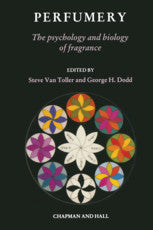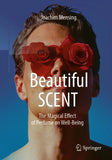Perfumery: The Psychology and Biology of Fragrance By Toller & Dodd
PERFUMERY : The Psychology and Biology of Fragrances
edited by Steve Van toller & George Dodd
Hardcover, 268 Pages
Chapman & Hall, 1988
This is a All time Best Seller Book , and Must Have Book for anyone who is interested in Perfumes.
in 1951 Oellinek, 1951), until the conference held at the University of Warwick in 1986 there has previously never been a joint meeting of the industrial and academic disciplines relating to the sense of smell. Each year brings the launchings of many new perfumes; the respective national perfumery societies hold meetings; conferences on the sense of smell take place. These events involve the exchange of important knowledge relating to perfumes but the information remains largely isolated. The Warwick Olfaction Research Group is unusual in that it is led by two people, one of whom is a practising perfumer with an understanding of what it means to be asked to create a perfume, and the other a psychologist with an expertise in the area of emotion. Our interaction (Dodd and Van Toller, 1983) was a potent stimulus to hold the First International Conference on the Psychology of Perfumery. The main purpose of the meeting was to see if there was a framework that would knit the area together into a coherent set of ideas and also to give new perspectives to the study of perfumes. We invited speakers from all areas of the discipline. Thus, the meeting brought together people from the fragrance industry, academics and aromatherapists into a forum for debate. Besides the scientific basis of smell and perfumery, other important topics, including the important one of educating the general public about; olfaction and perfume, were discussed.
TABLE OF CONTENTS :
PART I : The Biological Underpinnings of Scents.-
1 Human odour culture: a zoological perspective.
- 1.1 Introduction.
- 1.2 Man: the scented ape.
- 1.3 Ecological and behavioural background to the evolution of modern man.
- 1.4 Incense and perfume.
- 1.5 The nose and emotion.
- 1.6 Conclusion.
2 The molecular dimension in perfumery.
- 2.1 Molecules and perfumes.
- 2.2 Perfumery and the psychology of art.
- 2.3 Perfumes and sensory processing.
- 2.4 Perfumery and allied crafts.
- 2.5 Perfume molecules.
- 2.6 Perfume oils and aromatherapy.
- 2.7 Synthetic odorants and the psychological frontiers of perfumery.
- 2.8 Receptor events in perfumery.
- 2.9 Conclusion.
3 The significance of odorous steroids in axillary odour.
- 3.1 Introduction.
- 3.2 The human axilla.
- 3.3 The apocrine glands.
- 3.4 Composition of apocrine secretions.
- 3.5 Microbiology of the axilla and its relationship to axillary odour.
- 3.6 Odorous steroids present in apocrine sweat.
- 3.7 Formation of odorous substances in the human axilla.
- 3.8 Odour of 16-androstenes: psychology and significance.
- 3.9 Sensitivity to musk odours.
- 3.10 Psychological experiments using odorous steroids.
- 3.11 Pheromonal aspects of odorous 16-androstenes in the pig.
- 3.12 Mechanisms of perception of odorous steroids.
- 3.13 Conclusion: perspectives for future studies.
PART II Developmental and Social Aspects of Fragrance.
4 The acquisition of odour hedonics.
- 4.1 Introduction.
- 4.2 Physiological and behavioural responses of prelingual infants.
- 4.3 Related animal research.
- 4.4 Postlingual children.
- 4.5 Children’s vocabulary for hedonic properties.
- 4.6 Conclusion.
5 Perfume as a tactic of impression management in social and organizational settings.
- 5.1 Introduction.
- 5.2 The impact of perfumes on first impressions.
- 5.3 The impact of perfume during employment interviews.
- 5.4 The ‘sweet smell of success’? Sex of applicant and interviewer and perfume as determinants of ratings in simulated interviews.
- 5.5 ‘Too much of a good thing’? Effects of scent and non-verbal cues on evaluations of job applicants.
- 5.6 General discussion.
PART III Odour Perception and the Language of the Brain.
6 Contingent negative variation (CNV) and the psychological effects of odour.
- 6.1 Introduction.
- 6.2 The experiments.
- 6.3 CNV amplitudes at different sites on the scalp.
- 6.4 Effects of odours on CNV.
- 6.5 Conclusion.
7 Emotion and the brain.
- 7.1 Introduction: Homo sapiens, the microsomatic smeller.
- 7.2 The sense of smell.
- 7.3 Emotion.
- 7.4 The biosocial theory of emotion.
- 7.5 Emotion and olfaction.
- 7.6 Psychophysiology.
- 7.7 Brain-evoked potentials.
- 7.8 Brain electrical activity mapping.
- 7.9 Conclusion.
PART IV Fragrance Therapies.
8 Anxiety reduction using fragrances.
- 8.1 Introduction.
- 8.2 Stress: the vicious circle.
- 8.3 Relaxation training.
- 8.4 Problems with traditional relaxation techniques.
- 8.5 Enhanced relaxation therapy: key features.
- 8.6 Action of fragrance: a closer look.
- 8.7 Odours and disease.
- 8.8 Use of fragrance alone.
- 8.9 Construction of the fragrance.
- 8.10 Further refinements.
- 8.11 Role of fragrance in enhanced relaxation: verification.
- 8.12 Applications of enhanced relaxation therapy.
- 8.13 Wider applicability.
9 Essential oils as psychotherapeutic agents.
- 9.1 Historical background.
- 9.2 Twentieth-century aromatherapy.
- 9.3 Effects of essential oils on emotional states.
- 9.4 Concepts of mood evocation with essential oils.
- 9.5 Conclusion.
PART V The Consumer and Perfume.
10 The psychology of fragrance selection.
- 10.1 Is selection of a perfume a matter of chance?.
- 10.2 The subjective experience.
- 10.3 The desired life-style.
- 10.4 Sociobiographical data and climatic factors.
- 10.5 The Colour-Rosette Test.
- 10.6 Trends in perfumery from a sociological point of view.
- 10.7 A few basics about trends.
- 10.8 Characteristic traits of a trend.
- 10.9 Life cycles of aesthetic trends.
- 10.10 Change of self-perception: the main perfume trends in recent years.
- 10.11 The new world of fantasy and what it offers.
- 10.12 The ‘fun-type’.
- 10.13 Magic fantasy: the view into the past.
11 Perfume, people, perceptions and products.
- 11.1 Introduction.
- 11.2 Smell marks people.
- 11.3 Smell marks brands.
- 11.4 People do differ.
- 11.5 Perception differences.
- 11.6 Difficulty of explaining responses to perfume.
- 11.7 Conclusion.
12 Selling perfume: a technique or an art?.
- 12.1 Introduction.
- 12.2 Selling a perfume.
- 12.3 Training a perfume sales assistant.
- 12.4 The customer’s attitude.
- 12.5 Conclusion.
13 Fragrance education and the psychology of smell.
- 13.1 Introduction.
- 13.2 The Fragrance Foundation.
- 13.3 Fragrance education.
- 13.4 Future developments in the fragrance field.
- 13.5 Conclusion.
- References.
- Author Index.


















